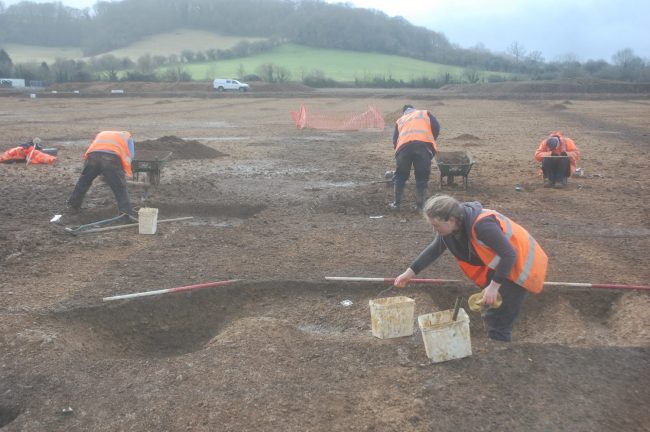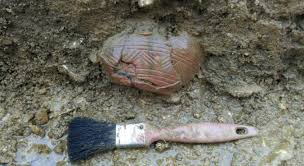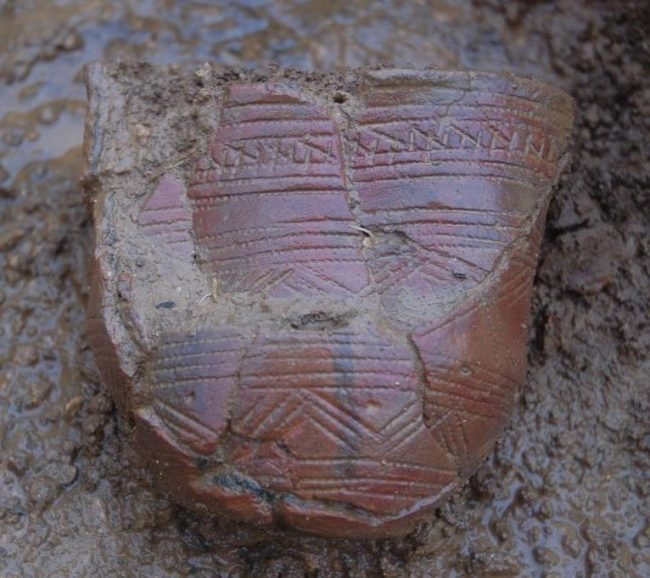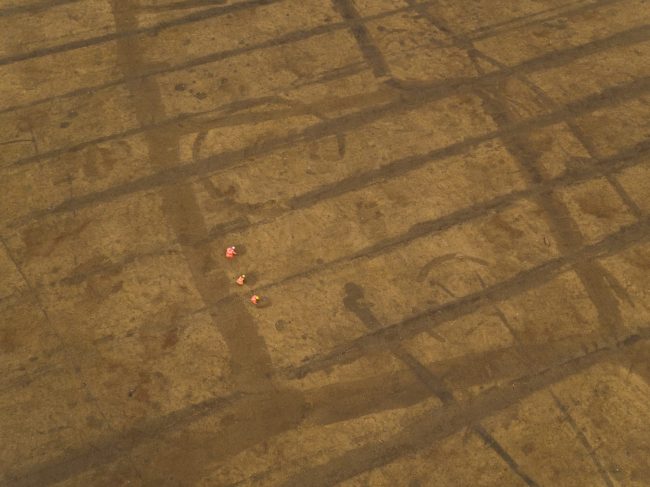The mystery of the empty grave…
- 30th October 2017
In the second of our Halloween inspired blog posts we take a look at a recent site which produced a grave that was seemingly missing a body!
During late 2016 and early 2017 a team from Worcestershire Archaeology carried out one of the largest excavations in their history in connection with the creation of a new flood storage lagoon on the edge of the village of Broadway.

Archaeologists at work on the Broadway Flood Alleviation Scheme
The dig revealed evidence for over 10,000 years of human activity alongside Bunches Brook, beginning with Mesolithic hunter-gatherers and including some intriguing Bronze Age finds dating back over 4000 years. The main focus of the site was a large Iron Age and Roman settlement along with what may be very rare post-Roman or Saxon buildings. Medieval remains were also found that predate the foundation of a planned town at Broadway in the late 12th or early 13th century, which later shrank in size to become the historic centre of the village we know today.
The mystery began one afternoon in late December 2016 as archaeologist Jamie Wilkins started excavating a large oval pit, about 1.5m in diameter. As he reached the bottom he uncovered the base of a prehistoric pot. Careful cleaning revealed the pot was decorated with distinctive horizontal bands and chevrons and it was quickly identified as an early Bronze Age Beaker, dating from around 4000 years ago. This footage recorded by the team shows the Beaker being excavated.
Beaker culture appeared in Britain in the Late Neolithic period (3000 – 2500 BCE), running through into the Early Bronze Age (2500 – 1500 BC) and takes its name from the distinctive pottery beakers that are usually found with burials of this date. It also includes the introduction of ideas and technologies including metalworking in copper, gold and bronze, the development of archery, and shared types of decoration, seen on the Beaker pots themselves, that have been recorded from as far west as Ireland, east across Europe to Poland and down through Spain, Portugal and Italy.
While these characteristic pots are usually associated with burials on this occasion there was no sign of any bone. Bone doesn’t always survive well on archaeological sites – it can dissolve over time in acidic soils, sometimes leaving only teeth and sometimes nothing at all. However, other well-preserved burials had been found during the excavation so the team knew that this was unlikely to be the case here.
After calling in site director Richard Bradley and rethinking their strategy, Jamie and Richard cleaned the face and top of the unexcavated half of the pit once more and were able to identify where it had been dug into again at some point in the past before being filled-in once more. Excavating the other half of the pit revealed more artefacts, all typically found with Beaker burials. These included flint arrowheads and knives, an antler tool and perhaps most intriguingly a piece of the Beaker in the backfill on the other side of the pit from where the main body of the pot had been found, but still no bones…

The partially excavated Bronze Age Beaker pot
So was this a grave and if so what had happened to the occupant? The absence of any bone at all, even the smallest, most easily missed bones from the hands, feet and ear suggests that any body was removed before it had decayed and was still fleshed. So was this perhaps a case of premature burial – did the occupant wake up buried beneath a weight of cold, dark earth and claw their way out of the grave? A terrifying prospect fit for Halloween but perhaps unlikely.
Is the answer more simple and less ghoulish? Bears and wolves were present in Bronze Age Britain and it is possible that the corpse was dug-up by a scavenging animal and either dragged away or simply reburied somewhere safer after having been disturbed?
The small piece of the Beaker found separate from the main part of the pot and the way in which none of the other artefacts in the grave had been disturbed might suggest that an animal was not involved unless only part of the body had been exposed and scavenged. The piece of Beaker had probably been broken-off and scooped up when the body was exhumed and then ended up back in the grave when the upcast soil was placed back in. This suggests that the hole had been filled in quite quickly with the material that came out of it and that removal of the body was both deliberate and took place before it had decomposed. If the body had rotted, leaving just the skeleton then great care must have been taken to make sure that all of the bones were collected.

The Beaker after excavation and cleaning.
So why was the body removed – could it have been stolen by grave robbers? While we know that such practices happened in later periods of history we have no evidence from the Bronze Age for grave robbing purely to gain access to a corpse. However, a Beaker Burial recorded from Irthlingborough in Northamptonshire contained only part of a male skeleton, buried with a range of grave goods like those found at Broadway. Other partial burials have been found elsewhere in the UK and it appears that during the Early Bronze Age it was not unusual for burials to be opened up again later and part of the skeleton removed or for only part of the skeleton to be buried in the first place. In some cases burials have been found missing particular parts of the skeleton while in others only certain parts of the body such as a limb or skull were present. Archaeologists believe that these practices may have been related to some form of ancestor worship or celebration, where the bones of the ancestors were displayed to the community on special occasions or even stored or buried in the house as a means of celebrating links with the landscape and past generations. We may never know for sure if the pit was a grave but the artefacts, particularly the Beaker suggest that it probably was. As to why the body was removed – for now we can only guess.
The main excavations finished in early March 2017 and since that time post-excavation assessment work has been keeping the finds team and site director busy. This is the term archaeologists use for all the tasks that are done once the team comes off site. They include washing and identifying all the finds, checking all the site records, dating and phasing the features that have been investigated, and then building up a picture of what it all means! As part of this the Finds team has already recorded nearly 5000 artefacts and further updates on progress with the report that will be produced as a result of all this work will be posted in 2018.

An aerial view of the Flood Alleviation Scheme excavation
Post a Comment